Fukushima and more
- Sort by
- Popularity
- Name
-
Imari ware/Arita ware Imari yaki Arita yaki
- Ceramic
- Saga
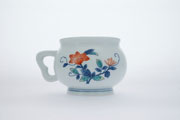
Imari ware and Arita ware are both porcelain produced around the town of Arita, in the Saga prefecture. Imari ware and Arita ware are light and delicate and both have excellent durability because their porcelain is produced from porcelain stone. T…
View more
-
Bizen ware Bizen yaki
- Ceramic
- Okayama

Bizen ware (called Bizen yaki in Japanese) is a form of pottery produced in the area around the city of Bizen in Okayama prefecture. Bizen ware is one of Japan's Six Ancient Kilns. Together with Shigaraki, Tamba, Echizen, Seto and Tokoname, B…
View more
-
Koishiwara ware Koishiwara yaki
- Ceramic
- Fukuoka

Koishiwara ware (called Koishiwara yaki in Japanese) is a form of pottery produced in the Asakura district of Fukuoka prefecture. Since its creation, Koishiwara ware has evolved to become a practical, beautiful pottery. Koishiwara ware's uniq…
View more
-
Yuki tsumugi silk Yuki tsumugi
- Woven textiles
- Ibaraki

Yuki tsumugi silk is produced principally in the reaches of the Kinugawa River that straddles the Ibaraki and Tochigi prefectures. The Japanese name Yuki tsumugi comes from the name of a feudal lord during the Kamakura period (1185-1333), Yuki. Al…
View more
-
Hakata doll Hakata ningyo
- Dolls, kokeshi
- Fukuoka
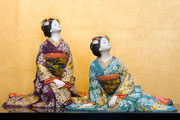
Hakata dolls (called Hakata ningyo in Japanese) are unglazed clay dolls produced in the city of Hakata, in Fukuoka prefecture. The notable features of Hakata dolls are their subtle soft colors, delicately carved expressions, and curves that almost…
View more
-
Karatsu ware Karatsu yaki
- Ceramic
- Saga
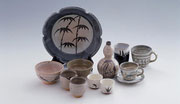
Karatsu ware (called Karatsu yaki) is a form of porcelain produced in the Saga and Nagasaki prefectures. This traditional craft has been produced since the 16th century in various forms, including tea bowls. One of the most notable features of Kar…
View more
-
Kasama ware Kasama yaki
- Ceramic
- Ibaraki

Kasama ware (called Kasami yaki in Japanese) is a form of porcelain produced in the area around the city of Kasama in Ibaraki prefecture. This porcelain has long been considered a traditional souvenir of visiting Kasama Inari shrine (one of Japan&…
View more
-
Kurume traditional resist-dyed textiles Kurume gasuri
- Woven textiles
- Fukuoka

Kurume traditional resist-dyed textiles (Kurume gasuri in Japanese) is a woven cloth produced in and around the city of Kurume, Fukuoka prefecture. The breathability assures coolness in the summer and excellent heat-retaining properties provide wa…
View more
-
Hakata brocade Hakata ori
- Woven textiles
- Fukuoka
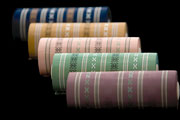
Hakata ori refers to the ori or woven cloth produced in and around Hakata, Fukuoka prefecture. Hakata weaving techniques, which originated in China, have shaped this unique cloth. It has been highly regarded for its high quality throughout the age…
View more
-
Aizu lacquerware Aizu nuri
- Lacquerware
- Fukushima
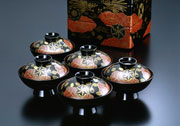
Aizu lacquerware (called Aizu nuri in Japanese) is lacquerware made in the Aizu region of Fukushima prefecture. During the manufacturing process, the craft is classified into round pieces, such as bowls, and flat pieces such as trays or stationery…
View more
-
Takaoka copperware Takaoka doki
- Metal works
- Toyama
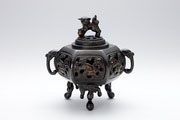
Takaoka copperware (called Takaoka doki in Japanese) is a type of copperware produced in the area around the city of Takaoka in Toyama prefecture. The various products range from small items such as indoor ornaments, Buddhist tools, and vases to l…
View more
-
Agano ware Agano yaki
- Ceramic
- Fukuoka
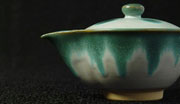
Agano ware (called Agano yaki) is a form of pottery produced around the town of Fukuchi in Fukuoka prefecture. Agano ware is elegant and lightweight, stemming from its development as a tea bowl for use in tea ceremonies. In some cases, the foot o…
View more
-
Inami wood carvings Inami chokoku
- Wood, bamboo crafts
- Toyama
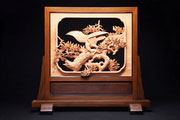
Inami woodcarvings (called Inami chokoku in Japanese) are produced in the city of Nanto, Toyama prefecture mainly in the form of transoms*, decorative objects, and single-leaf screens**. They are usually made of Japanese camphor, paulownia, or zel…
View more
-
Obori-soma ware Obori soma yaki
- Ceramic
- Fukushima
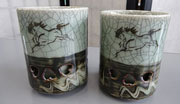
Obori-soma ware (called Obori-soma yaki in Japanese) is a form of porcelain produced around the town of Namie in Fukushima prefecture. This craft uses blue porcelain enamel which is made from locally collected grindstone. The distinctive feature …
View more
-
Aizu-hongo ware Aizu hongo yaki
- Ceramic
- Fukushima
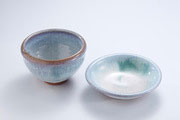
Aizu-hongo ware (called Aizu-hongo yaki in Japanese) is a traditional handicraft from the region of Aizu in Fukushima prefecture with a history of about four hundred years. This pottery, which is thought to have originated during the Sengoku perio…
View more
-
Sakai cutlery Sakai uchihamono
- Metal works
- Osaka
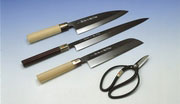
Sakai traditional blades are hammer-forged knives produced in the cities of Osaka and Sakai, Osaka prefecture. To achieve both strength and cutting quality, this craft is made by combining soft iron and steel. This craft is forged to have a sharp…
View more
-
Takaoka lacquerware Takaoka shikki
- Lacquerware
- Toyama
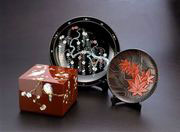
Takaoka lacquerware (called Takaoka shikki in Japanese) is produced in the area around the city of Takaoka, in Toyama prefecture. A defining feature of this lacquerware is the wide range of techniques and styles. Aogai-nuri is a technique that use…
View more
-
Osaka naniwa pewterware Osaka naniwa suzuki
- Metal works
- Osaka
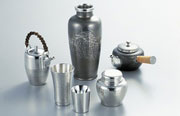
Osaka naniwa pewterware (called Osaka naniwa suzuki in Japanese) is a metalwork produced in and around the city of Osaka, Osaka prefecture. In the past, tin mined in Japan was used, but today it is imported mainly from Thailand and Indonesia. This…
View more
-
Osaka Buddhist altar Osaka butsudan
- Household Buddhist altars
- Osaka
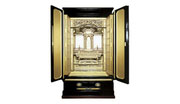
Osaka Buddhist altars (called Osaka butsudan in Japanese) are produced in the cities of Osaka, Yao, Higashiosaka, Sakai, and Kishiwada in Osaka prefecture. Along with the standard lacquer-painted, gold-leafed altars, this region is also known for …
View more
-
Yame lanterns Yame chochin
- Other crafts
- Fukuoka
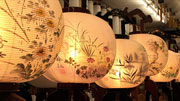
Yame Lanterns (called Yame Chochin in Japanese) are a type of lantern craft produced in the region around Yame, Fukuoka prefecture. This craft has a bamboo frame and a fire box with beautifully painted flowers, birds, and plants. The bamboo frame …
View more
-
Echu traditional Japanese paper Echu washi
- Traditional Japanese paper
- Toyama

Etchu washi is traditional Japanese paper made in Asahi, Yatsuo, and Taira in Toyama prefecture. Each production area makes their own type of washi which are called Gokayama washi, Yatsuo washi, and Birudan washi. This craft has slight regional va…
View more
-
Osaka carved wooden panel Osaka ranma
- Wood, bamboo crafts
- Osaka

Osaka Transoms (called Osaka Ranma in Japanese) are transoms produced in and around the cities of Osaka, Kishiwada, and Suita in Osaka prefecture. In a Japanese-style house, transoms are wooden panels attached between the ceilings and lintels of t…
View more
-
Okuaizu Basketry Oku aizu amikumi zaiku
- Wood, bamboo crafts
- Fukushima
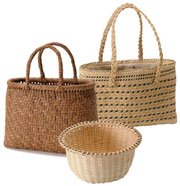
Okuaizu Basketry, called Okuaizu Amikumi Zaiku in Japanese, is basketry produced around Mishima Town, Onuma County, Fukushima Prefecture. As this mountainous area in the Okuaizu region has much snow and farmers are unable to work in the fields in …
View more
-
Katsuyama bamboo crafts Katsuyama take zaiku
- Wood, bamboo crafts
- Okayama
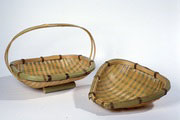
Katsuyama Take Zaiku are bamboo baskets produced in Maniwa City, Okayama Prefecture. Bamboo ware products are made in many areas across Japan from a variety of bamboos such as thick stemmed bamboo and black bamboo. However, Japanese timber bamboo …
View more
-
Osaka karaki wood joinery Osaka karaki sashimono
- Wood, bamboo crafts
- Osaka
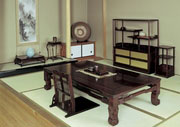
Osaka Karaki Wood Joinery, called Osaka Karaki Sashimono in Japanese, are wooden articles manufactured in several cities of Osaka Prefecture. Karaki is wood from trees mainly grown in Southeast Asia, and include rosewood, ebony, Chinese quince, an…
View more
-
Yame-fukushima Buddhist altar Yame fukushima butsudan
- Household Buddhist altars
- Fukuoka
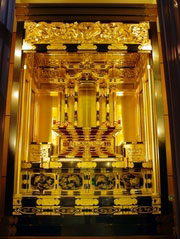
Yame Fukushima Butsudan are Buddhist altars made in Yame City (former Fukushima Town), Fukushima Prefecture. Dotted with many temples, the Yame region had been a place where there were many devout Buddhists since ancient times, which supported the…
View more
-
Makabe stone lanterns Makabe ishidoro
- Stonework
- Ibaraki
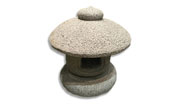
Makabe Ishitoro is the Japanese name for Makabe stone lanterns produced around the town of Makabe in the Ibaraki Prefecture. Production of this traditional craftwork started during the Kamakura period (1185-1333). The stone industry in the Makabe …
View more
-
Osaka bamboo screens Osaka kongo sudare
- Wood, bamboo crafts
- Osaka
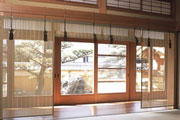
Osaka Kongo Sudare are bamboo blinds produced in the cities of Tondabayashi and Kawachi-Nagano in Osaka Prefecture. Tondabayashi City lies at the foot of Mt. Kongo, the highest mountain in Osaka, and good quality Japanese timber bamboo growing nat…
View more
-
Osaka-senshu traditional paulownia chest Osaka senshu kiri tansu
- Wood, bamboo crafts
- Osaka
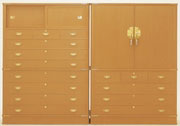
Osaka Senshu Kiri Tansu are wooden chests of drawers made in and around Kishiwada City and Sakai City, Osaka Prefecture. They are made from Paulownia wood, much appreciated for its durability, excellent moisture barrier properties and fire resista…
View more
-
Shogawa woodcraft Shogawa hikimono kiji
- Industrial art materials and tools
- Toyama
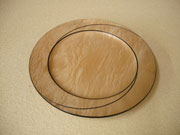
Shogawa woodcrafts are mostly woodcraft articles such as bowls or trays made in a wide area of the Toyama Prefecture including the city of Takaoka and the city of Tonami. Shogawa woodcrafts were designated as a traditional craft by the Ministry of…
View more

































































































































































































































































































